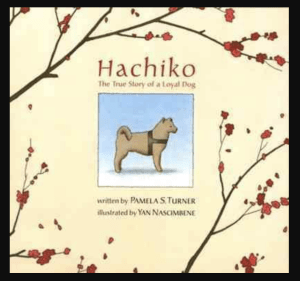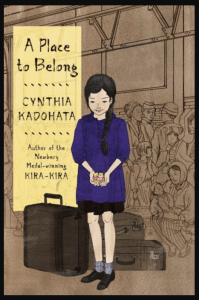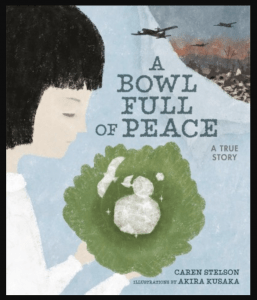Turner, Pamela S. Hachiko: The True Story of a Loyal Dog. Boston: Houghton Mifflin Co., 2004.
Do animals feel emotions? Anyone who has ever lived with a dog knows that they feel many emotions: fear, joy, loneliness…. And of course, loyalty. This short story, presented as a picture book illustrated by the award-winning Yan Nascimbene, describes the history behind a statue at a famous Tokyo train station. While the main character – a young boy – has been invented, the story of Hachiko – a dog who for almost ten years faithfully went to the station every day, hoping to once again meet his master who had died – is true. This touching story set in the 1920s is appended with two pages of historical information and is recommended for dog lovers of all ages.
Japan
A Place to Belong
Kadohata, Cynthia. A Place to Belong. New York: Atheneum, 2019.
Twelve-year-old Hanako, her younger brother, and her parents have been incarcerated in internment camps ever since the bombing of Pearl Harbor in 1942. Although the war is now over, her family is still not wanted in America, so her parents give up their American citizenship and move to Japan. Her grandparents are overjoyed to see them, but Hanako doesn’t feel at home. She is too American to blend into Japanese life. And the poverty is overwhelming.
This 399-page novel is an outstanding addition to the historical fiction genre. The facts of post-war Japanese life are smoothly embedded in an emotionally powerful story – with an unerring sense of voice – highly recommended for competent readers 11 years old and up.
P.S. This is a superb novel for a small group study. Numerous thought-provoking sentences will promote connections between the story and readers’ own lives…
“‘When I walked away last time…I never looked back….I was scared it would make me change my mind'” (90).
“‘…you must forgive….I see and hear many bad in world, many bad….but there is also many good. So we move forward in life, neh? When we can, we move forward'” (105).
“This was the thing about being spoiled: you had to rise above it” (136).
“There was not enough; this was a fact. The world was filled with facts that could not be changed. She had learned this during their camp days. There were many, many, many facts” (158).
“‘Maybe same thing make you sad, make Japanese children happy'” (189).
“‘You did the right thing….You may cry. But don’t forget that you did the right thing'” (204).
More stories of historical fiction
A Bowl Full of Peace
Stelson, Caren. A Bowl Full of Peace: A True Story. Minneapolis: Carolrhoda Books, 2020.
Sachiko was six years old on August 9, 1945 when an atomic bomb was dropped on Nagasaki. War had already come to Japan. People were already going hungry from lack of food and hiding in air raid shelters built into the hillsides. When the bomb dropped, one of Sachiko’s brothers was killed, and the rest of the family became ill and slowly started dying of radiation sickness. Sachiko’s remaining family members continued to gather around grandmother’s bowl every evening – just as they had before the war – to offer thanks for their food. But once a year, they instead filled the bowl with ice and – as it melted – also prayed for peace. This quietly heart-breaking story of courage, poignantly illustrated by Akira Kusaka, is highly recommended for readers seven years old and up.
Stories of conflicts after WW2
Stories of conflicts before WW1
P.S. Writers – and teachers of writing – notice how the story is written in present tense even though it really happened long ago. How does that make the story more powerful? How does it help readers – and listeners – enter the story? Notice, as well, how the story starts with the bowl passed from mother to daughter. How can this family custom help readers identify with the characters in the story? Notice how sight and sound, taste and touch, are all part of the story. Notice the use of repeated words and phrases, the use of short sentences for emphasis, and how the few spoken sentences in quotations summarize the whole story.
Erika-san
Say, Allen. Erika-san. Boston: Houghton Mifflin Co., 2008.
A little girl, seeing a picture of a teahouse in her grandmother’s home, becomes curious about Japan. She reads books about Japan, learns how to speak Japanese, and – after she grows up and finishes college – moves to Japan to become a schoolteacher. But busy Tokyo doesn’t appeal to her. She longs for the countryside. She finally finds it, a little village that reminds her of the picture from long ago, a place where she makes a friend, marries him, and creates her new home.
Some reviewers have criticized this picture book for depicting a character that dislikes a foreign city, for writing about a character appropriating another culture as her own. But this quietly beautiful picture book isn’t about displaying political correctness or conveying moral messages. It is a story about someone who admires a way of life and goes out to find it. It is a story for everyone who has had a dream and then set out to find it. Recommended for reflective readers 9 to 12 years old.



